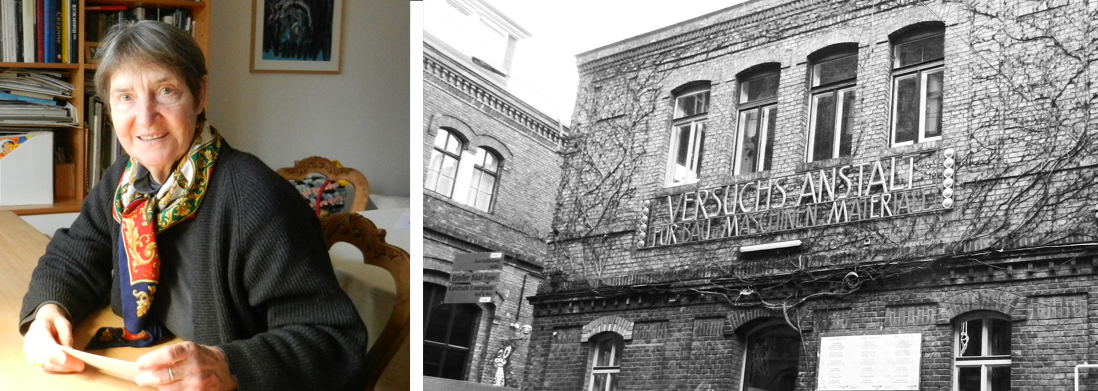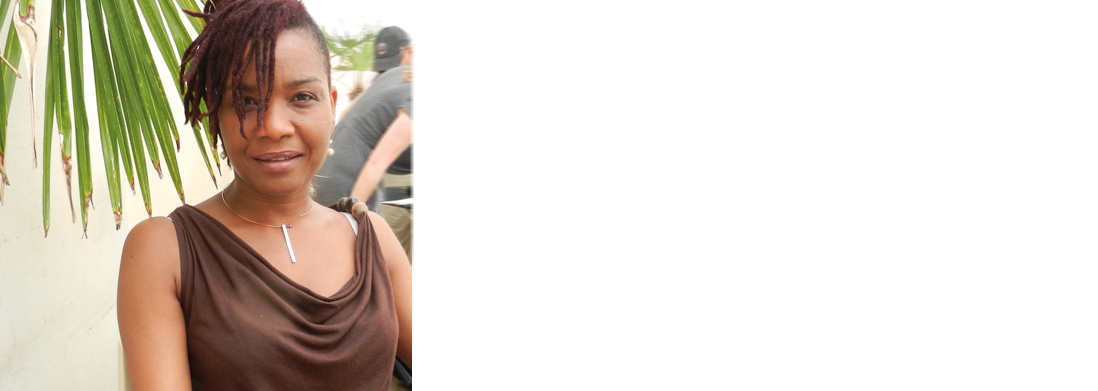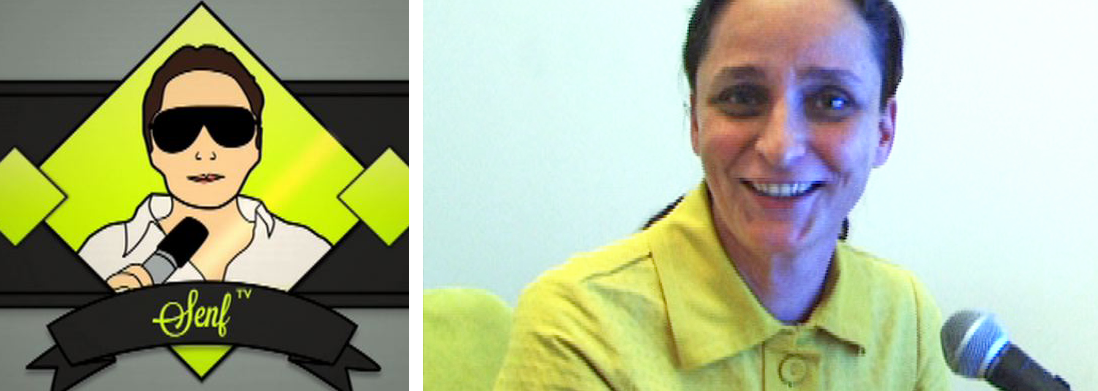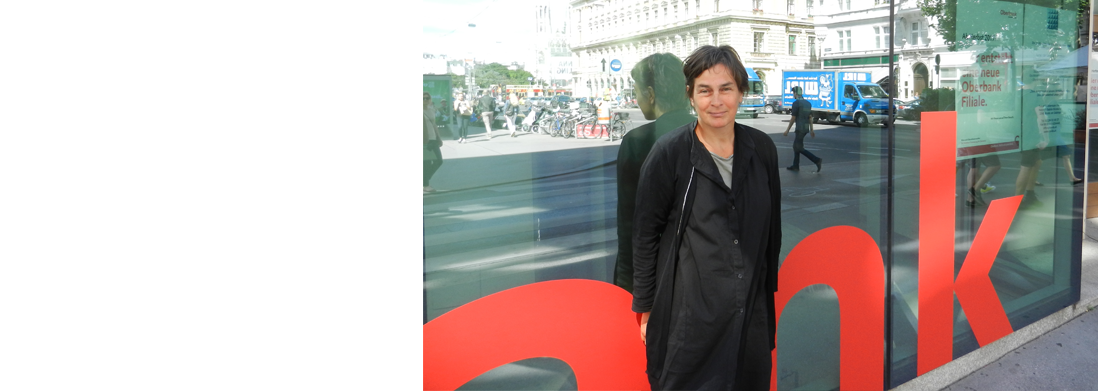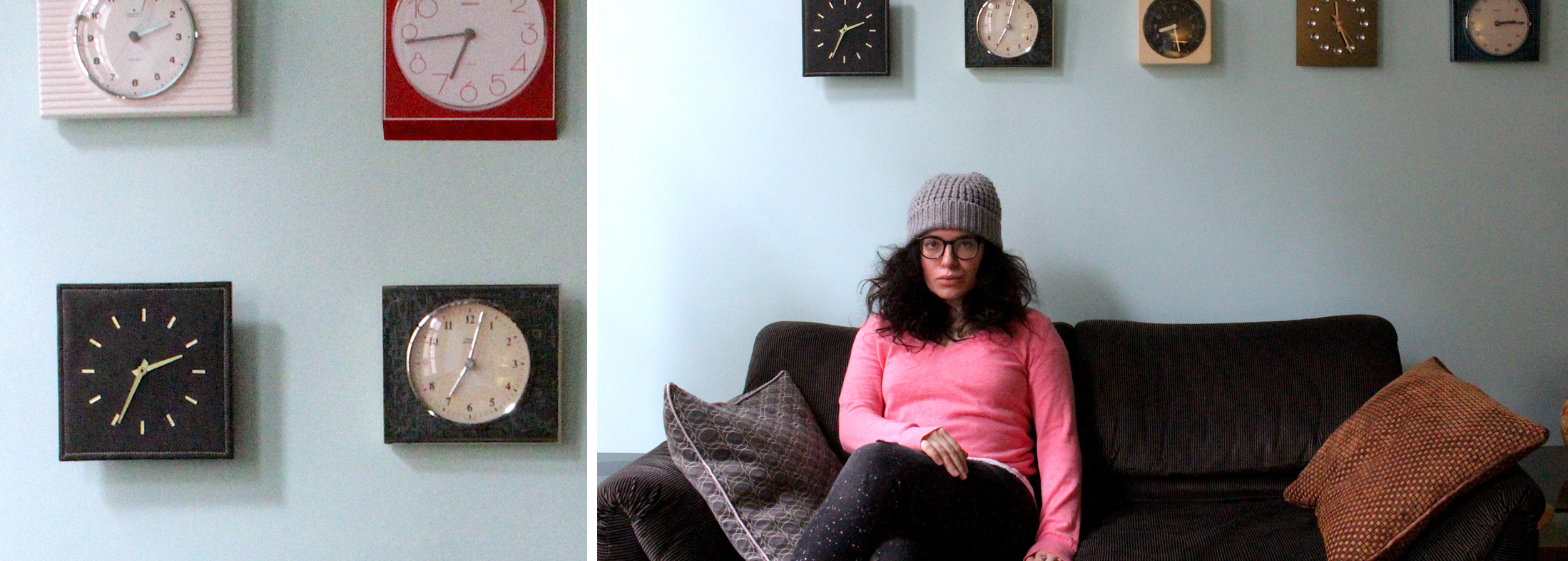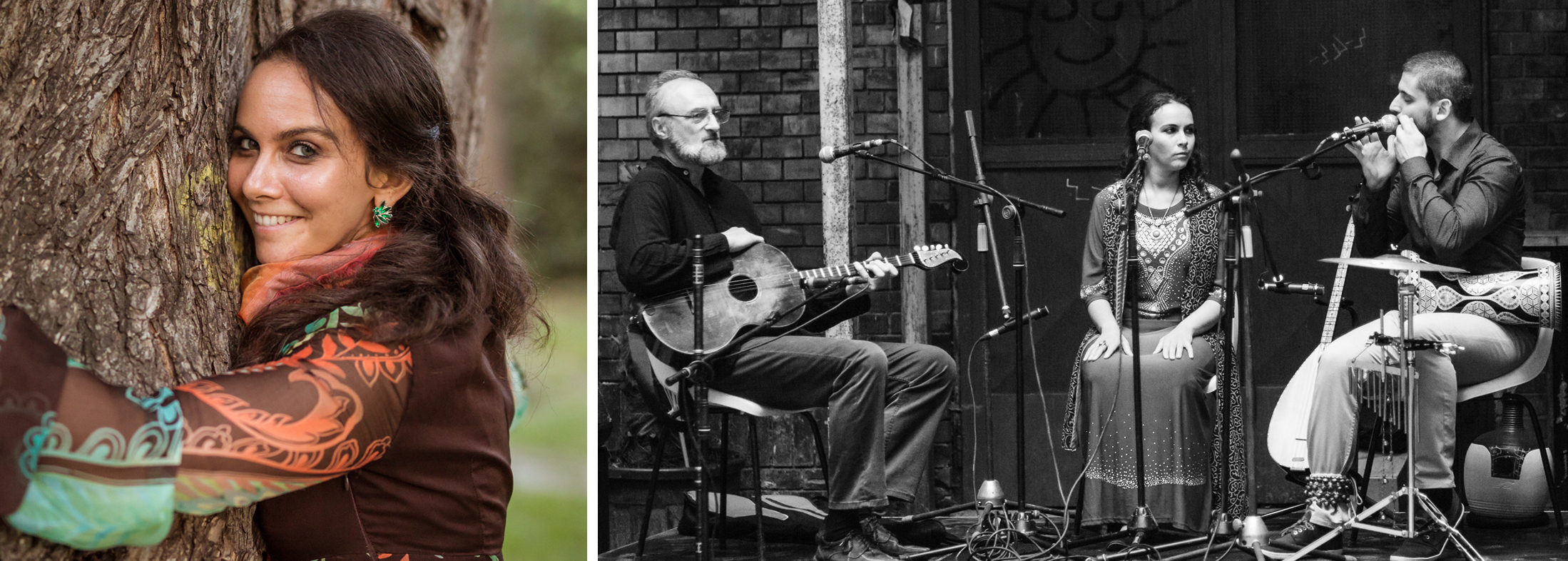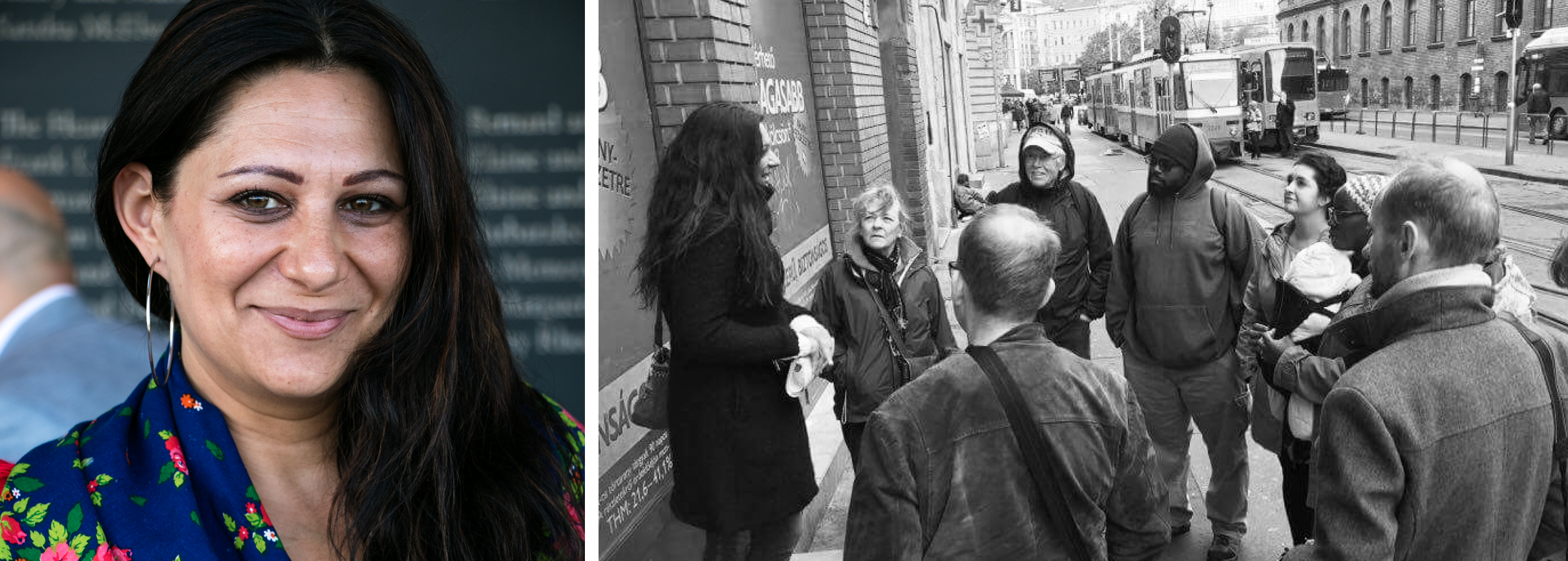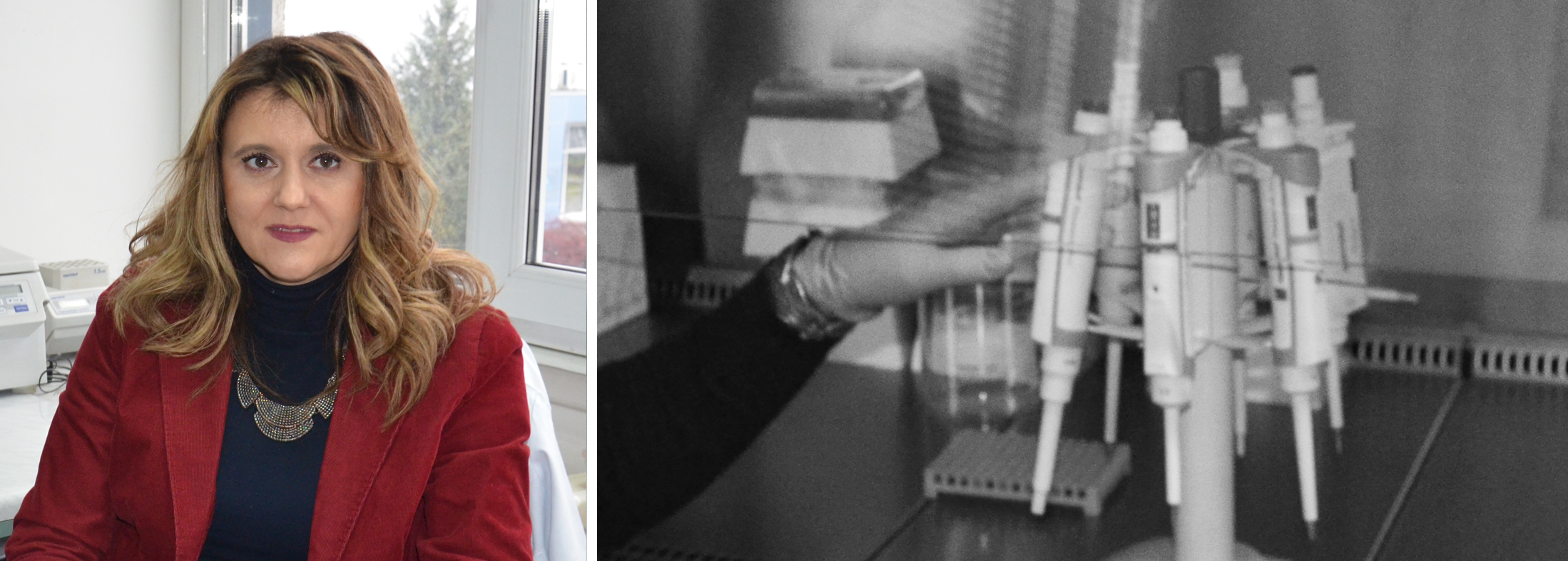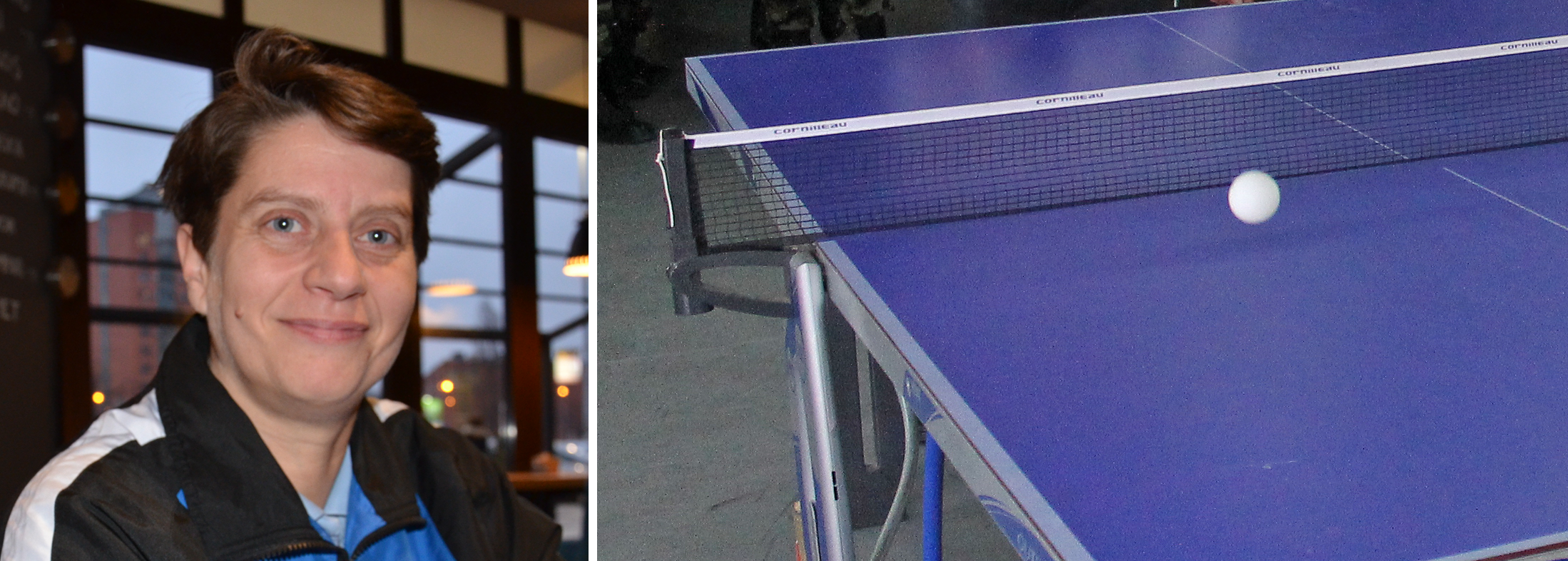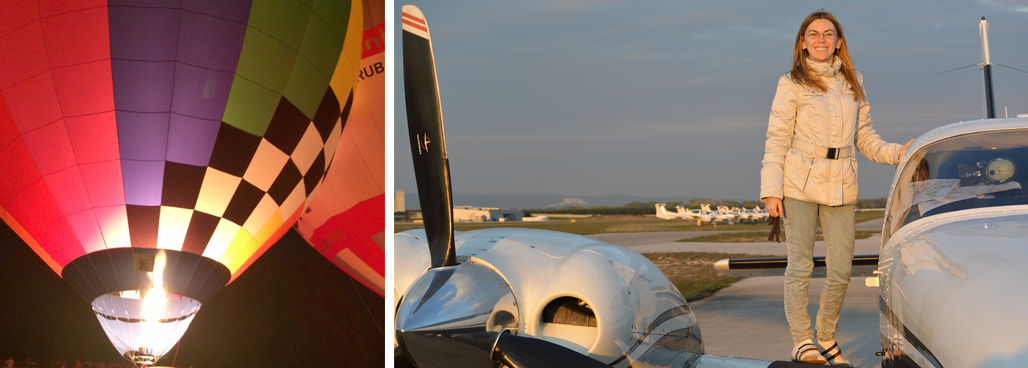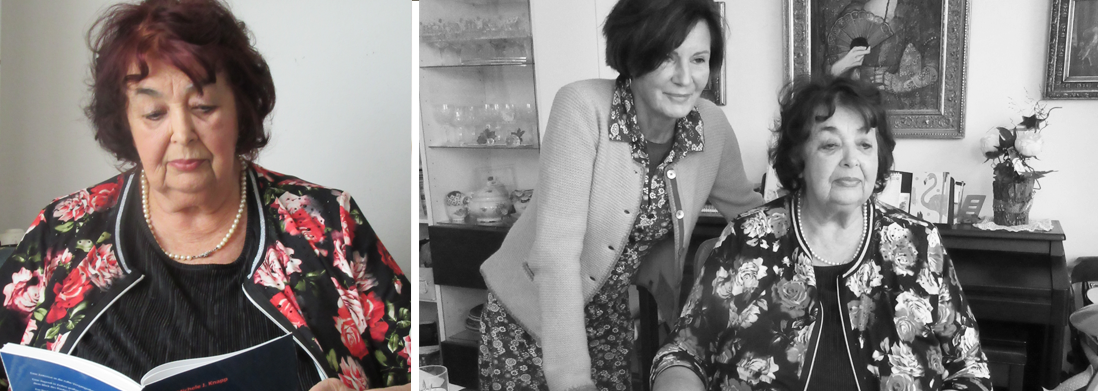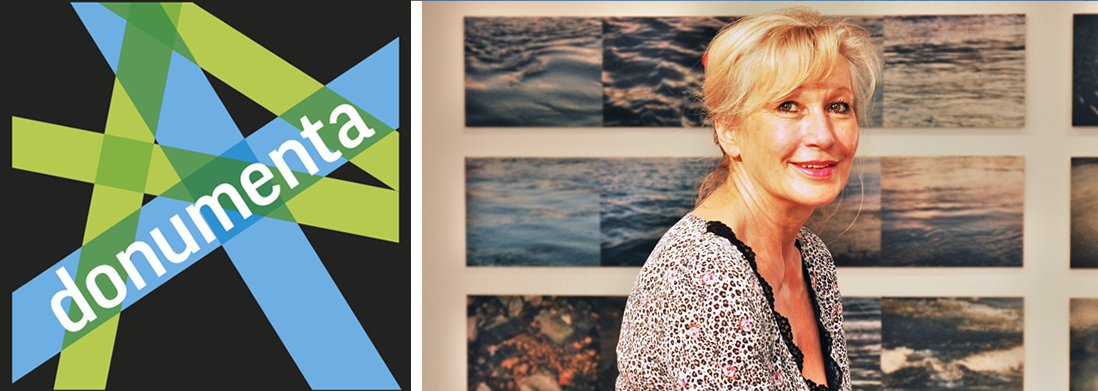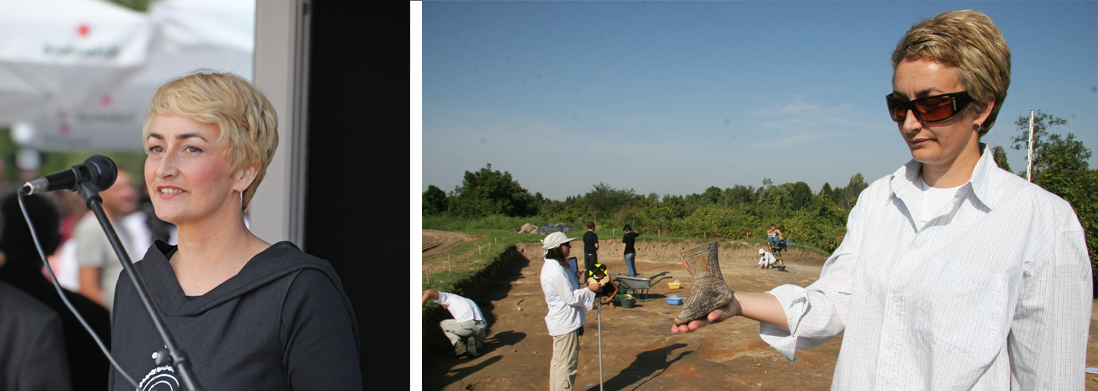OVERVIEW
So here they are: interesting, fascinating and smart women who make (or made) an important impact in their field of work for our societies along the river Danube. Our selection of stories from our different partnering countries is based on the desire to make visible efforts and achievements of women who deserve more visibility, more acknowledgements and more appreciation.
Ronja Kemmer is a politician and one of the youngest members of the German Bundestag for the district of Ulm. She is also a member of the European Committee in Berlin, but whenever it is possible, she is enjoying Ulm, appreciating the high living standard of this city.
She has always been very active in discussions about political issues and when finishing school, she started to engage in politics, especially in topics of education. For her it would be important that young people get involved in political debates, taking responsibility of their own life’s, even when it is not easy to be youngster in political world today. She is supporting women to take more risks and get active, in business, in voluntary work or in politics.
Her advice for young women who want to start a political career?
‘You have to be active and you have to take some risks sometime. It is not a disaster if you fail, just try again. Don’t let men always go first.’
http://ronja-kemmer.de/
https://www.facebook.com/ronja.kemmer/
Uschi Knapp is the Head of the ”Region of Innovation” Ulm
What advice would you give women who strive for a career?
I don’t believe that there is anything like the one real advice. So much depends on situations and different people that one meets at a certain point in time. Of course, being a woman – that’s the experience I made – it’s almost always like you need to achieve a little bit more to be recognized. Male colleagues may just have a different appearance by nature. As a woman, you have to learn to develop your own way and not to want to be “the better man”.
My advice: just be consistent, to be yourself and defend your own interests.
Iris Mann is a Mayor for culture, education and social affairs.
Do you have a favorite place in Ulm? And what makes it so special for you?
Yes – the beach chair on my roof terrace. This is where I can look over the city in peace and quiet, with a clear view as far as the Alps and let my thoughts wander.
What should visitors in the city of Ulm definitely take a look at?
Definitely the Cathedral of Ulm and there climb the highest church tower in the world!
Ariane Müller didn’t plan a career as a musician. Although she studied journalism, she played music to finance her studies and at one point she realised – I am a musician!
When she earned her first money at the age of 14 playing the piano at a funeral, she thought: Wow, that is great, other people have work hard and get a job, but I am paid for just playing the piano!
Today she is very successful with her band ‘Suchtpotential’ (addictive potential). Together with her colleague Julia Gaméz-Martin she got an engagement for the Rocky Horror Picture Show at the theatre in Ulm and then the duo started to write own songs. Suddenly they had to engage management for booking – until now for over 100 shows a year.
Ariane wants to reach people by using humour. People without humour are not in her target group. She likes to perform, it is fun for her.
Any advice for young women seeking a career in the music world?
‘It sounds quite general, but it is so important: Stay yourself and don’t get bent by others. Of course, you need luck, too. If you are in a good mood, you must keep going on. Don’t be affected by critical voices. If you do something well, it will eventually prevail.’
Ariane Müller has three children – any tips for mothers?
‘Having children shouldn’t keep anyone from pursuing a successful career, especially not women. To be a mother is just a classic role model and we have to escape these gender stereotypes.’
www.youtube.com/watch?v=SB46Tz63lsA
Petra Schmitt is a Designer and creative artist.
What is your favourite place in Ulm – and why?
There isn’t the one and only favourite spot for me. Sometimes in any case that would be the “Stiege”, but in general it is the Danube area, especially in summertime. It is very important to me to have water in a city. Water is calming, it eases. In general I particularly like the many urban sites the city has to offer. Also the area of ‘Kreuz’, where we have our studio is very important to me. Here are many locations with special memories for me.
Leandra Ardizzone, artist, painter, lives and works in Vienna since 2015. She intensively dealt with Elias Canetti’s Crowds and Power in Palermo, in theatre workshops with Claudio Collovà. In Vienna, she tries to “get lost in the city”, she walks a lot, meets new people, she needs these impressions through her eyes. By this, she sees new aspects of Vienna every day and night, and then goes to her workspace, to draw and to paint. People’s postures in public space, she says, remind her of Canetti’s book: they are more vertical, stand alone side by side, the horizontal relations are missing.
She has her own studio to work in, but supports herself by working in gastronomy. Many inspirations come from there as well: it helps to remember her past, and to connect with the present.
Where to meet Leandra Ardizzone:
www.facebook.com: Sirena sogna
Instagram: Sirena sogna
Eleonore – Lore – Kleindienst, architect and civil engineer, was born in Vienna in 1940. Already as a young child, she accompanied her father to his building sites in the Waldviertel, and became acquainted with the profession. She studied architecture at the Technical University Vienna; after graduation, she worked with several architects to learn more about planning. While on maternity leave with her second daughter, she devoted time to study sociology and psychology. Always interested in the social ideas and their architectural realisations of the Viennese interwar period, she wanted to move and change more, and participated in congresses on global housing challenges and in social research about living conditions: and ‘slowly, things began to change in Vienna’.
She then was responsible for adaptation of Vienna’s WUK – Werkstätten- und Kulturhaus (a large building used by many independent groups for artistic and social initiatives), which became her first project as a civil engineer with her own bureau in 1985.
The RosaLila Villa – a home for LBGTQ people – was a further step in her dedication to new forms of living; then followed the planning and realisation of the music club Chelsea at the Gürtel.
Her career took on a new direction when Lore Kleindienst renewed village structures in the Waldviertel north of the Danube. She also got assignments to plan and build bridges, and gave a proof of her talent to connect, for movement and flows.
Women in architecture became a later dedication of hers. Having organised a congress for female civil engineers in Austria, and an exhibition and a large-format book about 100 years of Women in technical professions, she then moved on to co-edit ArchitekTouren, a book about female architects’ works in all Austrian federal states.
Meanwhile, she emphasizes, women are taking part in all relevant professional committees. Yes, a platform is needed from which opening and change can proceed! The Danube Women City Guide is one of these platforms.
Karine LaBel is a dancer and dance teacher.
With her fusion between Afro-Haitian, modern and jazz dance, she is among those who re-interpret rhythmical movement. At the age of 16 she attended her first dancing lesson in Port au Price, Haiti, Jazz dance. “At home, all children were dancing”, she remembers. When a friend of hers came to Haiti to learn how to play the drum, she followed his path to encounter the rituals and musical approaches of her home country. She learned the background of the religion, the dance, singing, the drums. It was her teacher in Haiti who named her LaBel after the spiritual being ‘la belle Venus’. She went to Paris with him and made music there together.
The embassy of Haiti engaged her in 1996 for an engagement in Vienna, a town, she knew a lot about already from TV, like the New Year’s Concert of the Vienna Philharmonic Orchestra and all the movies about the Austrian empress Elisabeth, Sisi. She came back to Vienna more often, for workshops, to talk about religion in Haiti at the University of Vienna; she played with the Vienna Symphony Orchestra and had a performance in the Austrian television. At the first Hallamasch-Festival she won her first award and others followed. She could feel how important it was to bring this culture to Vienna. She could live here as an artist, write plays and give dance classes, e.g. at the international dance festival ImpulsTanz.
What do you teach in your classes?
“I found something the people were missing, this center, this inner information they were searching for. I learned from the Austrian students, what they need, and to be able to translate it, to have the capacity to teach this very strong art from Haiti. Teaching is about trust! I hold dance workshops in Vienna for over twenty years now.”
Karine, what are your favourite places in Vienna?
“The WUK was an important place for me, my first workshops were there, I feel that my spirits are there, the building, the energy. I also like the Brunnenmarkt and the Arsenal, which has a very strong energy that I can still not describe. And the Museumsquartier: It is also a part of my beginning, where I rehearsed my first piece in Austria – back then, it was not so beautiful like it is today.”
Susanne Luschin is a pioneer of the early web- and television scene in Vienna. Today, she not only teaches video journalism at the participative community channel Okto TV, but also at the University of Vienna. Her own TV format is “Senf” (“Mustard”). Tips where to go in Vienna is one of its contents, something she started in the 1990s with a telephone service line. She also had a Fake-News-Blog, was the host and DJ in a club, and participated in Austria’s first privately-owned television channel TIV. Soon, she had her own show, and developed her talent for journalism, organization, and technical requirements. Supported by a dedicated and creative team, she produced legendary programs, with guests perching on inflated sofas and tubes.
Later, in 2003, she started in mobile youth work, together with artist Amina Handke. Disadvantaged young people were supported, not only in creating videos, but also in finding jobs.
Although she had creative experiences in Rostock and in Munich, the ‘place to be’ for her was Vienna. Having moved to Vienna from Graz when she was nineteen, first jobs soon materialized through friends. She designed and made costumes for the theatre and also for artistic contexts. Important was for her to meet people in the budding music club culture and in contemporary art galleries, places, where a certain mixture of people came together. Back then, she holds, ‘you had to go, there was no internet, you had to read the papers yourself, attend concerts yourself’.
Where to see Susanne Luschin’s recent film work:
okto.tv/senf
okto.tv/unicut
Martina Reiter is a musician. The sixth of eight children, she started her instrumental practice early, and developed her skills on the piano, the violin, and the viola. During her teenage years in Linz, she found her way into the alternative music scene, while keeping up her approach to classical music, in choir singing and orchestra playing.
In Vienna, where she moved with 18, she took up her studies of music again at university. In the surroundings of squatted houses, she initiated the Culturehall and organized concerts and live music. In the late 1980s, her dream to move to New York materialized. There, she was again active in the movement for Housing is a Human Right. Back in Vienna, she organized cross-over concerts and early hiphop gigs. All this gave her the incentive to work on her own musical development, and she found new life in old classical music, and also in folk music of the Innviertel in Upper Austria. And getting closer to Jazz is presently an important way to find her inner music.
Her special interest is for people in Vienna to open up the ‚temples of high-culture’ to all, to bring music to children also from poor backgrounds, and to create more spaces in the city where people can meet.
Places in Vienna
The Viennese Prater, the Danube Channel, the Goldene Saal in the Musikverein, many places on the Danube, but also the Viennese markets, the woods around Vienna, the green and the water.
Listen to Martina Reiter’s music at www.klassikconnection.at
Photo credit: (c) Bernadette Reiter
Ula Schneider, an artist, initiated and manages the art festival SOHO in Ottakring. Since 2016, she is part of a team commissioned by the city of Vienna, that is responsible for “Leerstand und Aktivierung” in Vienna (activating the use of vacant spaces). After living in the U.S. as a child, and in Germany where she was working as an artist and had her first two children, she returned to Vienna and moved into an apartment at “Brunnenmarkt“ in the district Ottakring.
Ula started the urban art festival in 1999 to enable the exchange between people in the “Brunnenviertel“, to create cultural and artistic exchange in a day to day setting, as well as collaborations between artists, cultural workers, shop keepers and institutions on local as well as international level.
After fourteen years in the “Brunnenviertel“, SOHO moved to the area of “Sandleitenhof“, a large communal building complex from the 1920s located on the western edge of Ottakring. One of the main objectives is to work together with local people.
The biennial festival brings many artists into the area. One of the strengths of art is to address questions and problems using visual and generally sensual approaches: “We create settings and situations where people may get involved, so that they might experience new aspects of the everyday in context with others. It is so essential in a democratic society.”
Where to learn more about Ula Schneider’s interests:
www.sohoinottakring.at
Photo credit: (c) Danila Mayer
Andrea Ausztrics is a Filmmaker.
Andrea was born in Budapest, she works as a freelance creative producer, curator and media artist focusing on social issues and representations of cultural identity and memory. She studied at ELTE’s Arts, Humanities and Social Sciences Departments and at the NYU as a Fulbright scholar and holds master degrees in Aesthetics and Cultural Anthropology. Parallel to her projects, she is working on her PhD about Innovative Jewish Museums, a comparison between the European and the American best practices.
Majda Mária Guessous is a Junior Prima Prize winning Hungarian-Moroccan singer. She studied as a performer and teacher of folk songs at the Liszt Ferenc Academy of Music, where she became a professor of folk singing. Meshi’s voice has reached audiences not only in the US, Turkey, and Morocco, but in Kazakhstan, India, Bahrein, Kuwait and Saudi Arabia. As an artist of Yehudi Menuhin’s MUS-E Program, she holds music therapy sessions for socially underprivileged children.
In 2017, she became a TEDxYouth speaker.
Grafic artist, filmmaker
Dóra Maurer began her conceptual art practice in the late 1960s, combining various media. Her art educational and curatorial activities comprise an essential part of her oeuvre; she has been organizing exhibitions since the 1970s. At the same time, she initiated workshops dealing with visual education, film and photography. In 1990, she started an interdisciplinary painting class at the Hungarian Academy of Fine Arts. She is the first woman ever elected to lead the Széchenyi Academy of Letters and Arts.
Zsófia Schwikker is a Project manager of the Hungarian Food Bank Association
What made you choose your current job?
Inner motivation. I have experience working in both a multinational company and a small business environment in project management. I was bothered by the fact that, after the EU funded projects ran out, topics were simply sunk in a drawer. Fortunately, I came across a job at the Hungarian Food Bank and I still work there today, managing the official aspect of food rescue; we accept food donations from monitored sources and pass them on to the needy through partner organizations. I check that everything is going as it should in terms of the distribution of surplus food, storage, shipping, and selecting families in need.
Szilvia Szénási is the Chief Executive Officer of the UCCU Roma Informal Educational Foundation. She began her career as a family caregiver. Her work included community organization and the mitigation between Roma families and local communities. She studied Social Work at the Loránd Eötvös University, and later on completed a Roma Access Program at the Central European University in Budapest. She attended a family therapy training as well and acquired knowledge she successfully integrates into her work.
Dragana Zgonjanin Bosić is a DNA analyst.
What is essential for doing this job?
Well, primarily commitment, patience, persistence and knowledge. I think of myself as someone with emotion, because if you don’t have emotion you can’t be as committed to your job as I am. I think of this job as a privilege, not because other people think it is interesting, but because I love it and I think it couldn’t be done differently. I am happy because I do what I love, good people found me and contacted me because of who I am, and now some other professionals say that I’m doing this job well.
Svetlana Mojic Džakula is a Designer and architect.
“I believe in the spirit of a place, where every object should primarily serve as a frame for the nature in which it is placed to complete it. If the architecture fits into the place it is in, then I think that the object gets additional value and hence the object is better.”
Vesna Latinović is a Gallery owner.
“Being a woman is always difficult and always beautiful. It is always difficult because it is demanding, because there are many different responsibilities and roles we have to fulfill at the same time. On the other hand, it is beautiful because that zest and the ability to do things in parallel, to be multifunctional and to achieve good results in different fields – that is a woman’s characteristic, and that same zest and enthusiasm which a woman can have is very important and keeps us going. For this reason, making more effort is not difficult” says Vesna Latinovic.“
Borislava Perić Ranković is a table tennis sportplayer.
„When you think in a dark manner, everything will bother you and you will be unhappy. When your perspective is dark, then you have the feeling that you are missing a lot of things, which is not always the truth. And when you are looking from the brighter side, then you can see that many situations that we find disastrous in one moment, even after a few minutes don’t seem that disastrous anymore.“
Natalija Ribovic is a Media artist.
How do you incorporate your home town Novi Sad into your art?
With the Danube :). Novi Sad is a free city like a white dove, versatile in its social diversity and identity, and this is (in)visibly reflected, travels through the art in which I express where I am at that moment, and that is the World.
Your favorite place in Novi Sad?
I instantly think of the Kej (quay), a promenade along the Danube, my favorite place in Novi Sad. It inspires new lines of thought and ideas, my soul feels happy there.
“I always said that the Danube is my Danube.“
Born and raised on the Danube, more precisely in Orsova, Mehedinţi County, Isabella-Beatrix Voneafca (30), stage name Isa Berger, is an actress at the German State Theater Timisoara (TGST). In 2017, the young actress received two important prizes: the “Stefan Jäger“ prize for her work in 2016, and the Pro Timuraensis Culture Award, the most important cultural distinction of the Timis County Council. She has lived in Timisoara from the age of 13, more precisely when she switched to the German high school „Nikolaus Lenau“. During her high school years, she became part of the school theater group and this made her realize that her dream was to become an actress.
“The trajectory that leads from a child tending cows in the valley to the Stockholm City Hall is a strange one. Here, too, as is often the case, I am standing beside myself.“ These are the words of the German writer from Banat, Herta Müller, in her speech at the award ceremony of the Nobel Prize for Literature on December 2009.
This is why the Nobel Committee decided to give the highest distinction to the writer “who, with the concentration of poetry and the frankness of prose, depicts the landscape of the dispossessed”. Herta Müller herself belongs to the dispossessed.
Andreea Kremm, (37 years old) founded with her partner “Netex Consulting” in 2000, during her studies. A company, which has been growing ever since.
Today, Andreea Kremm owns several companies in different countries in Central and South-Eastern Europe, offering consulting services, web programming, office services, and lots of more services. Her secondary business is the organization of flights and balloon rides in Romania and especially in the Banat region. The young entrepreneur has allowed herself to “retire” at the age of 27, so she can devote herself to her hobbies.
She studied automatic control and computer engineering at the Polytechnic University of Timişoara, is a multi-engine aircraft pilot and the first Romanian woman with a seaplane license. What she likes most is to travel, meet new people and understand other cultures.
Georgeta Petrovici is a Journalist and PR consultant.
I love Timisoara. I am connected energetically to this place, my roots are here. Wherever I go, I’m not complete. After all, it’s a civilized place with beautiful people. If we look realistically, we have to admit that we are a provincial city regardless of whether we would like to be something different. I suffered for years when we were called that, but it is the truth. And this is actually not bad. I like this city because I think things can still evolve in the right direction. I think there is potential and, at some point, we will all wake up and we will begin to build. That will be the real revolution.
Erika Weisz, (31 years old, born in Timişoara, Romania) is one of those people, who managed to mix pleasure with work on a daily basis. She graduated the German high school Nikolaus Lenau, studied then Physical Therapy and Kinesiotherapy at the West University of Timisoara, is a qualified equine therapist, a general practitioner and at the moment she is studying for her Master`s degree in Psychotherapy and Clinical psychology at the Tibiscus University in Timişoara. Her love for people and horses made her attend the courses of the Equine Training Center in Milan, Italy. Since four years, Erika Weisz has been working with children with special needs at the „HorsEmotion” equine therapy and natural horsemanship center in Ianova, 22 km from Timişoara. The three-dimensional vibrations transmitted to those, which are riding a horse have a beneficial influence on the body and mind. Muscle strengthens; the breathing, balance and coordination of movements are improved. The interaction with the animal has a positive effect on the child who becomes attentively, focuses better and achieves a higher degree of independence.
She is one of the few equine therapist in Romania. The equine therapy or therapeutic horse riding is a type of therapy more recognized in the Western countries.
One significant statement of our interview, which says so much about her work: “None of my children feel like they are coming for therapy.”
Born 1977 in Amstetten, Austria, Anna Maria Brandstätter visited the University of Art Linz. She lives and works in St. Nikola, with exhibitions in Linz.
Her studio is located directly on the Danube?
The Danube influences my work and my life. In 2002 and 2013 there were floods, everything was flooded with 1.80 m, many of my drawings were broken. Today I have my apartment and studio on the first floor, it is safe when the flood comes. It was uncanny back then, you could only hear the sound of the water, the road was closed, no light, no electricity, you watch the water rise, threatening. But there was also great helpfulness, many volunteers, a beautiful community.
How was your way into art?
It took me a while to wake up. I always had the urge to create something. I was more interested in the garage than in the household.
From 2002 I studied painting and graphics, before that I worked for the gendarmerie for some years, at the time of the blockades at the border crossing to the Czech Republic, as a protest against the insecurity of the nearby nuclear power plant Temelin.
The study was a new world for me, with a scholarship and a part-time job with social night services. I tried a lot, photography, texts, prints, etchings, lithography. Today I paint two to three pictures a year in large format, the ideas I get from nature. The mood of the Danube, for example, changes every day, every hour. At sunrise, for example, the fog is as if in flames on the Danube.
What does responsibility in art mean to you?
Art should be affordable. I also make posters, design stickers like for the German presidential election “wöhn gehen – hophop”. As an artist, I would like to comment on current conditions, with democracy projects such as installations of slide texts of headlines from the newspaper.
Otherwise I don’t reproduce, I always have to find something myself, even if it’s just to integrate a new blue tone that others don’t perceive at all.
Michele Knapp was born in Linz in 1938 and fled to France to escape the persecution of the Jews. Lives, writes and tells today in Linz.
You write autobiographies?
Actually I wanted to write a book for my daughters, my publisher persuaded me to publish it. Now I am telling stories as a contemporary witness in schools. During readings it is quiet as a mouse, I feel the need to show how quickly you can get into situations if you believe everything without reflecting.
I visited the Mauthausen concentration camp memorial with French school classes and my daughter as a tour guide. It touched me very much to see how affected the young people were. The reality of the people who experienced persecution of the Jews is different from what you see on television.
Was the writing healing?
With the writing came fierce memories. It was not until I was 18 that I learned that my family had fled the persecution of the Jews. We escaped from the French Septfonds reception camp with barbed wire and raids only through a helpful captain of the deportation to Auschwitz when I was three years old. My father had to hide, the Gestapo also searched for Jews in France – and again someone helped us escape captivity. Later, we returned to Austria and my father was able to save someone who would otherwise have been sentenced as a Nazi.
Uprooted several times, how are you today in Linz?
At first I dreamed about France every night until my husband took me there. But everything was different, only the middle school was the same!
In Linz I worked for an industrial group. I have always written, at the age of 20 I captured my amorous adventures for myself. As an autodidact I painted pictures, today I work with stones.
My second book illuminates the years after my husband’s death. Many experiences were connected with this loss, and I asked myself, is society really only dependent on men? That can’t be.
Regina Hellwig-Schmid
What are you involved in? What do you burn for as an artist?
Art is able to convey difficult themes, for which we often lack the words, and to reach people.
In my art I advocate, among other things, the self-determined life of women. One of my first great themes to be artistically explored was Lilith, Adam’s first wife. Immersing myself in this myth was the trigger for me to deal with the topic of being a woman in our society. Difficult topics such as violence and much, which also means being a woman, to encircle and touch people with it.
I am a feminist and human rights activist. During the war in former Yugoslavia, which took place on our doorstep, women became victims of sexualised violence. – There it was again, my topic. The reports of these women shook me and I initiated the international art and peace action “pax danubiana”. I travelled to the Danube countries to set an active sign for peace. In autumn 2000, 1,867 artists* sent artistic or literary messages of peace as a message in a bottle to twelve cities along the Danube; “pax danubiana” was the beginning of donumenta.
For “pax danubiana” you received the award “Frau Europas”. How did this come about?
I had spoken at the Heinrich Böll Foundation about “pax danubiana”, how a small idea becomes a movement. I think that was decisive for the price. Every year, the European Movement awards a different woman for Germany. I am proud to be part of this group. These are all fighters, women who have left their comfort zone and are doing great things on a voluntary basis. Last year we honoured Düzen Tekkal, who liberated Yezidi women from the clutches of the IS.
What does Europe mean to you?
Europe is a community of values which we must defend despite all selfish and nationalist ideas. I am European, I come from Germany, I live in Bavaria and I live in Regensburg. I have no other thought. Europe is a place of longing for so many, and for me that is also proof that it is probably much better in Europe than elsewhere in the world.
What does the Danube mean for you?
For me, it is the river that flows through the most exciting and diverse cultural area. At the mouth, where the Danube is swallowed up by the Black Sea, it is also magical. – What the river has seen on 2800 kilometres, what I have met there for great people, I can’t describe it at all, such a wealth. A large community of nations lives here.
The writer Barbara Krohn grew up in Hamburg, lived for four years in Naples and for almost thirty years in Regensburg. She has published novels, stories and poetry and teaches creative writing.
How did you become a writer?
“Becoming” is exactly the right word. I have become more and more involved with language: I studied German and Italian language and literature, translations of Italian and American novels, my own poetry, book publications and nominations – and one morning I thought: Now you’ve actually become what you’ve always dreamed of. Writing is an intensive occupation with the inner world, the outer world, one’s own biography, history and the stories in one’s head, always new.
You grew up in Hamburg and now live in Regensburg. What does the Danube city mean for you and your literature?
The differences between North and South have shaped and enriched my life. Hamburg was largely destroyed after the war. I spent my childhood and youth in the big city, there was the harbour, the Elbe, but also bunkers and rubble plots. In contrast, Regensburg is almost an idyll with its medieval townscape, the traces of history and art.
I also travel back and forth and back and forth between the here and now and the past: with one leg in the north, with the other on the Danube. This is a constant balancing act that I live, I need this movement of the Neither-Nor and the Both-All-Auch. In this respect, Regensburg is a haven of peace and at the same time a place of departure.
They give courses for creative writing. How does that work?
Passing something on is part of my nature. I have always loved teaching Italian, tennis, literature, language and I am convinced that everyone who wants to write has their own writing voice that pushes outwards and wants to show itself. To accompany this and to promote the special in each case in the writing voices is a component of my courses, just like the variety of the texts, figures and stories. The craft of writing gives a basis, but the creative arises from the friction between the self and the world.
Why is writing a flowing movement?
It is no coincidence that people speak of writing flow: something comes into motion, words, figures, stories. Even when I move, stories come to mind when I am cycling, jogging or taking a train. In Hamburg on the Elbe the sea is not far – and in Regensburg the Danube connects me with many other countries. Life means movement, you never know what’s coming, what’s going to happen, what’s going to happen – it’s no different when it comes to writing.
Mirela Hutinec is director of the Museum of Vučedol Culture in Vukovar.
How did you discover your love for archaeology?
I discovered my love for archaeology quite early, still in school. By chance I came back to Vučedol and watched the excavations. So I became interested in archaeology. Later in the secondary school I also had an internship there and deepened this interest. Archaeology, which became my profession, means a lot to me, I regard it as something that guides me through life.
How do you see the future of the museum?
In any case very positive, because the digital age offers a multitude of possibilities. Our museum is designed to be contemporary; there is no exhibition in the classical sense, but it is multimedia. This gives visitors a direct experience of the history the museum tells. In the future, we will show the sky in a planetarium at Vučedol We will use the new technologies more and more and therefore I see a bright future for museums in general.
How do you see the connection between past, present and future?
From the past we learn how strongly the prehistoric people, including the settlers Vučedols, were connected to nature and respected it. We also realize that today we are alienated from it. I think that the knowledge about our cultural heritage and our identity is very important and that we, as Indo-Europeans, have to become aware that this is the starting point of our civilization.
What are your favorite tasks that you do in your work?
My favourite thing is to like new projects, to think of something new, to find solutions. If you have an empty sheet of paper in front of you and have to create something out of it, you wonder how you can get through to people. I love visualizing new ideas. I am also enthusiastic about the numerous possibilities of working with others when I realize how many fields we can work in.
What is your favorite place in the city?
I don’t like one place in town. Most people like the banks of the Danube and the Vuka, the city centre. But for me Vukovar is more than that. Vukovar is a whole series of small streets and alleys that I love to discover. When I stroll through them, I look at the different perspectives of the city. So the city always unfolds anew, although I know it from a very young age. This “corner” of Croatia has somehow fallen into oblivion, but our cultural heritage has the power to lure people here. Hopefully many visitors will continue to discover the numerous treasures here and enrich life in the city at the same time.
Vesna Bosanac is a doctor and head of the hospital in Vukovar.
What does your profession mean to you?
Actually, I’ve always wanted to be a doctor, from an early age. I always felt the need to help others, so I chose this profession. I finished high school in Vukovar and studied medicine in Zagreb. The profession of a doctor is very responsible, but the best thing is when I help people.
How is the ratio between male and female doctors in the Vukovar hospital?
There are definitely more women. If only the doctors were counted, there would be sixty percent women and forty percent men. If you count the entire hospital staff and believe the stereotype that a nurse is a female profession, we have a large proportion of men to oppose this. But we have, for example, 14 midwives, all women. It is sad that men who want to take up this profession are condemned by society.
They have received many awards and recognitions. Which means the most to you?
It’s true, I’ve been honored many times. But I find it most beautiful when I go to the marketplace or the bakery and people recognize me. “Hello, doctor, you cured my son, thank you for helping me. These words are actually a kind of distinction for my work. There is no better feeling and that is the greatest recognition I can get. If I had to name a formal award, it would be the honorary medal of the Croatian Medical Chamber.
What would you recommend to young medical students* why it is worth becoming a doctor*?
It is important to learn and to persistently pursue one’s goal. In this profession you have to invest a lot in training. Medical students have a lot of theoretical knowledge, but when it comes to practice, most hesitate to ask for advice. It is not bad to ask. It is bad not to ask and therefore to make mistakes. You should always ask experienced colleagues for help.
Do you have a favorite place in town?
This is undoubtedly the bank of the Danube. Already as a little girl and especially later as a schoolgirl I loved walks along the Danube. I have always been fascinated by its depth, size and course. I believe that the Danube has a special place in the heart of every city dweller of Vukovar.



